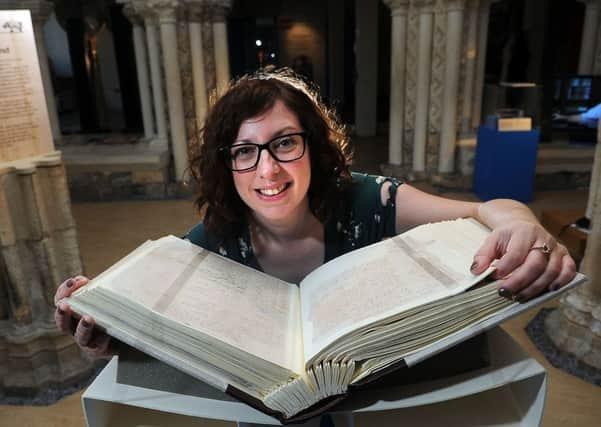New chapter on Richard III’s life in York


Now the campaign to bring him home to York has been given a boost as a 600-year-old manuscript giving a fascinating glimpse of the city’s relationship with the monarch goes on display for the first time in living memory.
The 15th century house book – one of a series of documenting the work of the city’s council – reveals how York flamboyantly prepared for his state visits and later mourned his death in 1485.
Advertisement
Hide AdAdvertisement
Hide AdNatalie McCaul, curator of archaeology at the Yorkshire Museum, said; “We are delighted to be able to put this book on public display for what we think may be the first time.
“This first hand-written account offers a unique window into the much talked about relationship between York and Richard III like nothing else in existence.
“It talks of the pomp and circumstance of his visit to the city – where people were made to clean the paths in front of their doors and put up banners from their windows.
“It describes his murder being a ‘grete hevynesse of this citie’ and how Henry VII’s messenger was afraid to visit after Richard’s death.
Advertisement
Hide AdAdvertisement
Hide Ad“But it also shows that even then the city wasn’t united in their support for Richard – rumour and reality were still deeply intertwined, with numerous tell-tale accounts of suspected treason noted.”
The hand-written volume was loaned to the museum by York Council as part of the city’s Richard III: Rumour and Reality programme of events.
It is on display alongside an 18-carat replica of a boar badge, the symbol citizens wore to show their allegiance to the king, which is up for auction.
The book, the second in a series of 80 tomes recording council meetings from 1476 through to the present day.
Advertisement
Hide AdAdvertisement
Hide AdThe earliest volumes chart Richard III’s rise to power in the north of England followed by the reaction to his death in the battle of Bosworth in 1485, when he was defeated by Henry VII.
Sonja Crisp, cabinet member for leisure, culture and Tourism, said: “The manuscript reveals an unusually intimate picture of a city courting the favour of royalty, while the expression of grief at Richard’s death was a risky gesture at a time when the new king was soon to impose his will on what he might have perceived as a rebel city.
“This house book survived floods at the Guildhall in 1892 and remains arguably one of the most important late medieval documents in the country.”
Throughout October and December, the book will be open at the pages detailing one of Richard III’s visits to the city, showing the preparations that were made, the money that was spent on hosting a Royal visit and the king’s activities there, such as watching the Corpus Christi Mystery Plays.
Advertisement
Hide AdAdvertisement
Hide AdIt will be open on the pages detailing the monarch’s death from January until April 27, when the exhibition closes.
King Richard III, known as Richard of Gloucester before his coronation in 1483, grew up at Middleham Castle in the Yorkshire Dales.
He visited York several times during his 26-month reign and also funded part of the city’s medieval gated walls.
His links to the city have led to a campaign to reinter his remains there after they were discovered by archaeologists under Greyfriars car park in Leicester. The Plantagenet Alliance, a group of descendants who claim it was his own wish to be laid to rest at York Minster, will take its fight against plans to bury him at Leicester Cathedral to the High Court in London next month.
Advertisement
Hide AdAdvertisement
Hide AdThe site was chosen by the University of Leicester, whose archaeologists and experts discovered his skeleton last September and confirmed it as his in February.
The institution was given the power to decide where to rebury the king as part of the terms of the licence to carry out the excavation at the site of the former Grey Friars Church.
But the Plantagenet Alliance claims the Ministry of Justice (MoJ), which granted the licence, failed to consult the public over the terms of the burial licence.
Granting permission for a judicial review, Mr Justice Haddon-Cave said: “It is plainly arguable there was a duty at common law to consult widely as to how and where Richard III’s remains should be re-interred.”
Advertisement
Hide AdAdvertisement
Hide AdThe MoJ announced last month it intends to challenge the judge’s decision to grant a review, which is currently set to be heard by three judges on November 26.
Justice Secretary Chris Grayling pledged to ”vigorously defend” the Leicester burial plan.